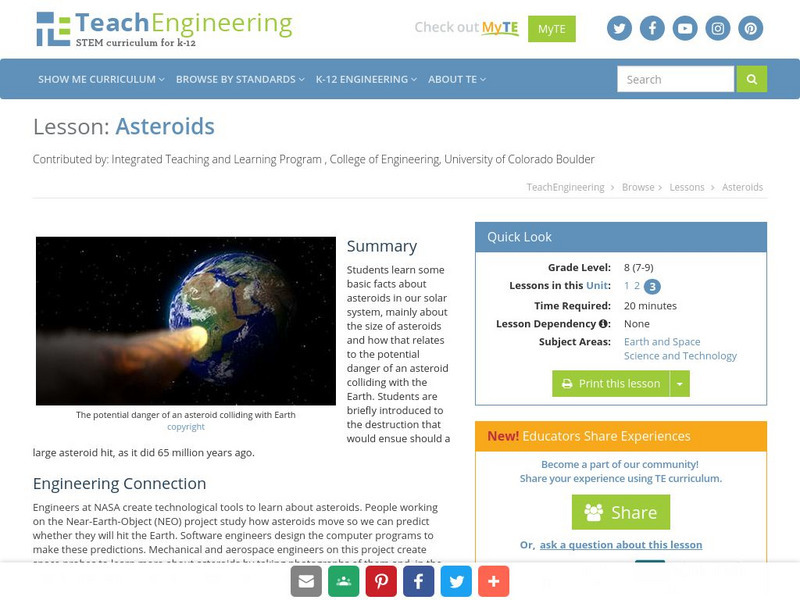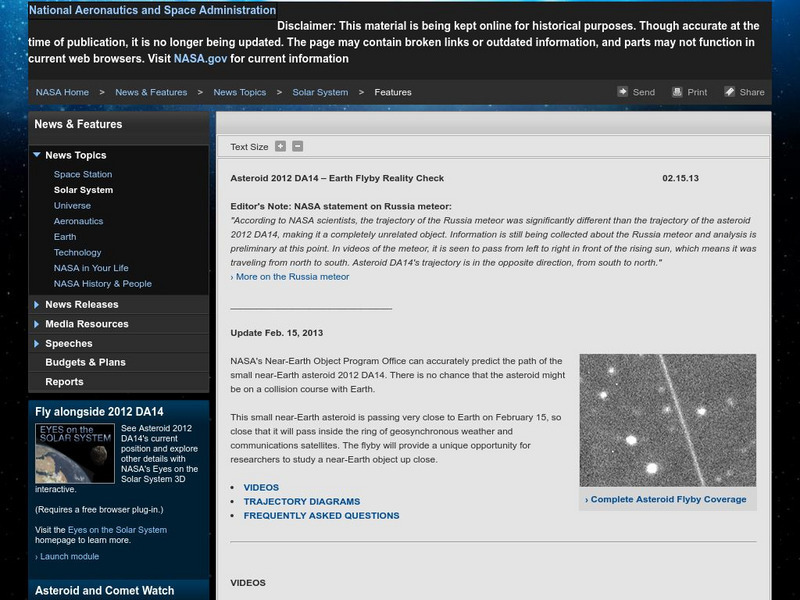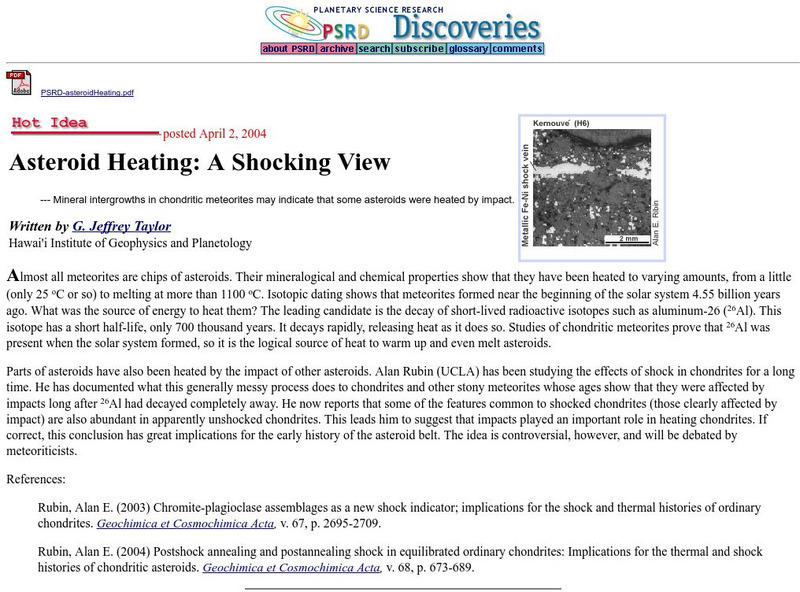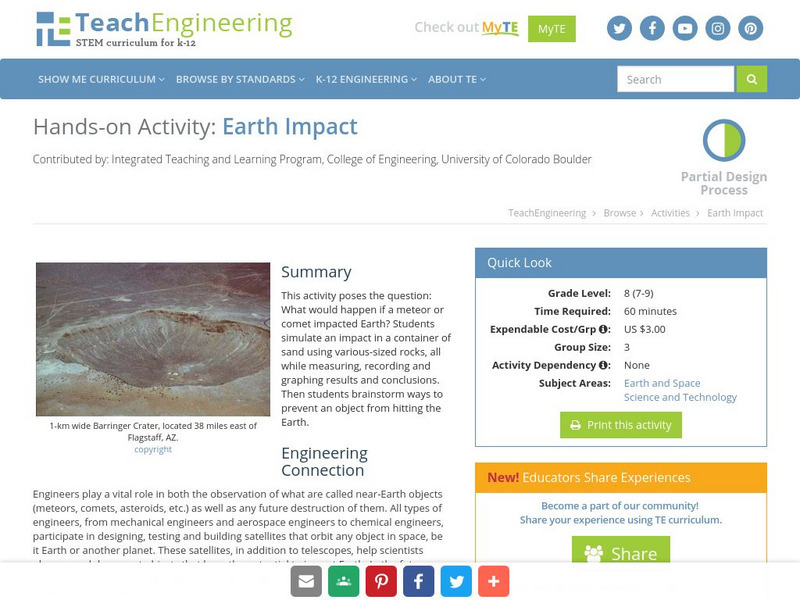Hi, what do you want to do?
Curated OER
Your Weight on Other Planets
Students explore their weight on other planets. In this science lesson, students view a presentation about the other planets and complete a worksheet in which they make predictions about their weight on the moon and other planets.
Curated OER
Exploring the Night Sky: Fall/Winter
Students explain how moon phases occur. They explain three ways that the night sky has been used through history. Students locate some of the constellations in the night sky. They discuss stories and myths surrounding stars.
Curated OER
The Next Logical Step in Astronomy
Students research future astronomy endeavors and how the exploration with contribute to astronomy and humanity. In this astronomy lesson plan, students research, present, and debate the topics as a class.
Curated OER
an Explorative Journey Through the Solar System
Students, in groups, research a planet from our solar system. They create Styrofoam models of the planets and place the planets on a correct distance scale from the sun.
Curated OER
Making Craters
Students study craters and identify the different things that characterize craters. In this crater lesson students create a model of an impact crater.
Curated OER
Solar System Fun Facts
Young scholars read facts about the Solar System. In this solar system lesson plan, students read facts on the dimensions, planets, and workings of the solar system. There is a big emphasis on Saturn.
Curated OER
The Vocabulary of Space
Students build their knowledge and understanding of vocabulary related to space. In this space instructional activity, students discuss four categories of words and phrases related to space.
Curated OER
Types of Galaxies
Eighth graders take a quiz to review the different objects in space. As a class, they define terms related to galaxies. In groups, they make a model of the Milky Way galaxy using materials provided to them by their teacher. To end the...
Curated OER
Our Solar System-- Fact File
In this space science worksheet, learners read facts about the solar system. Students look at the diagram showing the position of the planets. Pluto is included as a planet here.
Curated OER
Solar System
For this Solar System worksheet, 5th graders demonstrate knowledge of parts of the Solar System. Students unscramble letters to list these parts.
Curated OER
Our Home in the Milky Way
Students gain appreciation of the vastness of our galaxy by viewing an applet about the Milky Way. Students hypothesize about how long it would take to get from Earth to Pluto.
Curated OER
"Space" Investigations
Sixth graders understand the patterns of change observable on Earth as a result of the movement of the different bodies in the solar system. They identify the physical characteristics of the different components of the solar system.
PBS
Pbs Learning Media: Meteor Showers
This video segment adapted from NASA uses animation to illustrate the properties of meteor showers and comets. Included is are visualizations of a comet's tail and of Earth passing through a debris stream left behind by meteoroids.
NASA
Nasa: Asteroids: Overview: Ancient Space Rubble
Comprehensive look at asteroids, with many useful facts, photos, and related links. Provides a detailed account of how asteroids get their names and a timeline of significant dates.
TeachEngineering
Teach Engineering: Asteroids
Students learn some basic facts about asteroids in our solar system, mainly about the size of asteroids and how that relates to the potential danger of an asteroid colliding with the Earth. Students are briefly introduced to the...
NASA
Nasa: Asteroid 2012 Da14: Earth Flyby Reality Check
Get a reality check about a recent asteroid fly-by. Study videos, diagrams, and explanations of these near-misses.
Other
University of Leicester: Comets, Asteroids & Meteorites
Provides a general overview of comets, asteroids, and meteorites. Content includes ways to identify them in the night sky, as well as detailed information on each type of small body.
NASA
Nasa: Our Solar System Lithograph Set
View a lithograph set that includes pictures and brief descriptions of planets, sun, asteroids, comets, meteors, and meteorites. While viewing the lithograph learn important dates and interesting facts about our solar system.
NASA
Nasa: Russia Meteor Not Linked to Asteroid Flyby
The large fireball observed on the morning of Feb. 15, 2013, in the skies near Chelyabinsk, Russia, was caused by a relatively small asteroid that entered Earth's atmosphere at high speed and at a shallow angle. Preliminary information...
NASA
Nasa: Solar System Exploration
Enter our solar system to interact with the planets, moons, asteroids, meteors, and more. Investigate with NASA scientists and explore missions related to space exploration. Read facts, compare statistics, look through resources, and...
NASA
Nasa Space Place: Asteroid or Meteor: What's the Difference?
Learn the difference between asteroids and comets, meteoroids and meteorites, and more!
University of Hawai'i
Asteroid Heating: A Shocking View
This April 2004 article provides insight and one view into the world of asteroid heating, the age of meteorites and new theories in the changes in shocked and unshocked chondrites. Some great photomicrographs.
TeachEngineering
Teach Engineering: Earth Impact
This activity poses the question: What would happen if a meteor or comet impacted Earth? Students simulate an impact in a container of sand using various-sized rocks, all while measuring, recording and graphing results and conclusions....
Sophia Learning
Sophia: Asteroids, Comets and Meteors
A brief vocabulary overview describing the difference between asteroids, comets, and meteors.
























